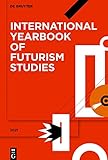International Yearbook of Futurism Studies. Volume 11, 2021 / ed. by Günter Berghaus, Monica Jansen, Luca Somigli.
Material type: TextSeries: International Yearbook of Futurism Studies ; Volume 11Publisher: Berlin ; Boston : De Gruyter, [2022]Copyright date: ©2022Description: 1 online resource (XXVI, 443 p.)Content type:
TextSeries: International Yearbook of Futurism Studies ; Volume 11Publisher: Berlin ; Boston : De Gruyter, [2022]Copyright date: ©2022Description: 1 online resource (XXVI, 443 p.)Content type: - 9783110751024
- 9783110752489
- 9783110752380
- online - DeGruyter
- Issued also in print.
| Item type | Current library | Call number | URL | Status | Notes | Barcode | |
|---|---|---|---|---|---|---|---|
 eBook
eBook
|
Biblioteca "Angelicum" Pont. Univ. S.Tommaso d'Aquino Nuvola online | online - DeGruyter (Browse shelf(Opens below)) | Online access | Not for loan (Accesso limitato) | Accesso per gli utenti autorizzati / Access for authorized users | (dgr)9783110752380 |
Frontmatter -- Table of Contents -- Editorial -- Section 1: Futurism Studies -- Futurism and Theosophy: Giacomo Balla and His Circle -- Making the Tables Dance: Seances, Ghosts and Futurism -- Stati d’animo: Futurism, Theosophy and Portraiture -- Desecrating the Divine, Sacralizing Humanity: Futurist Religion vs. Romantic Mysticism -- Futurist Dissonance, Theosophical Transcendence and American Musical Ultra-Modernism, 1909–1930 -- Esotericism and the Occult in F. T. Marinetti: Aspects of the Sacred in Futurist Gnosis -- Religious Traces within Polish Futurism: Entangled Ways of the Sacred -- Spanish Ultraism’s Sacred Woman of the Future -- Tullio d’Albisola’s L’anguria lirica (1934): Female Transubstantiation and a New Religion of Poetic Materiality -- Renewing the Sacred and the Sublime: From Early Futurist Manifestos to Marinetti’s Aeropoem of Jesus -- From Futurism to Spiritual Classicism: Gino Severini and the Neo-Catholic Avant-garde -- Leandra Angelucci Cominazzini: Revisiting the Futurist Debate on Speed, the Sacred and the Spiritual -- Section 2: Reviews -- Futurist Manifestos Revisited -- Santa Rita Pintor: Work and Life of a Portuguese Futurist Painter -- A New Study on Futurism in Sicily -- Notes on Two Novels in a Post-Neo-Futurist Key -- Section 3: Bibliography -- A Bibliography of Publications on Futurism, 2018–2021 -- Section 4: Back Matter -- List of Illustrations and Provenance Descriptions -- Notes on Contributors -- Name Index -- Subject Index -- Geographical Index
restricted access online access with authorization star
http://purl.org/coar/access_right/c_16ec
Dieser Band erforscht die spannungsreichen Beziehungen zwischen der futuristischen Kunstbewegung und dem Sakralen. Wie viele Intellektuelle des Fin-de-Siècle waren die Futuristen von verschiedenen esoterischen Strömungen wie Theosophie und Spiritualismus fasziniert. Sie sahen in der Kunst ein privilegiertes Mittel, um Zugang zu Seinszuständen jenseits der Oberfläche der weltlichen Welt zu erhalten. Gleichzeitig betrachteten sie mit Misstrauen die organisierten Religionen als gesellschaftliche Institutionen, die die Modernisierung behinderten. Zunächst wurden deren Symbole ironisch verwendet, doch in den 1930er Jahren entwickelten sie in Italien eine „Futuristische Sakralkunst", und eine neue Periode des Dialogs zwischen dem Futurismus und der katholischen Kirche setzte ein. Die Aufsätze des Bandes umspannen die Geschichte des Futurismus von 1909 bis 1944 in verschiedenen Disziplinen und geografischen Orten, von der polnischen und spanischen Literatur bis zur italienischen Kunst und amerikanischen Musik.
This volume explores the fraught relationship between Futurism and the Sacred. Like many fin-de-siècle intellectuals, the Futurists were fascinated by various forms of esotericism such as theosophy and spiritualism and saw art as a privileged means to access states of being beyond the surface of the mundane world. At the same time, they viewed with suspicion organized religions as social institutions hindering modernization and ironically used their symbols. In Italy, the theorization of "Futurist Sacred Art" in the 1930s began a new period of dialogue between Futurism and the Catholic Church. The essays in the volume span the history of Futurism from 1909 to 1944 and consider its different configurations across different disciplines and geographical locations, from Polish and Spanish literature to Italian art and American music.
Issued also in print.
Mode of access: Internet via World Wide Web.
In English.
Description based on online resource; title from PDF title page (publisher's Web site, viewed 25. Jun 2024)


